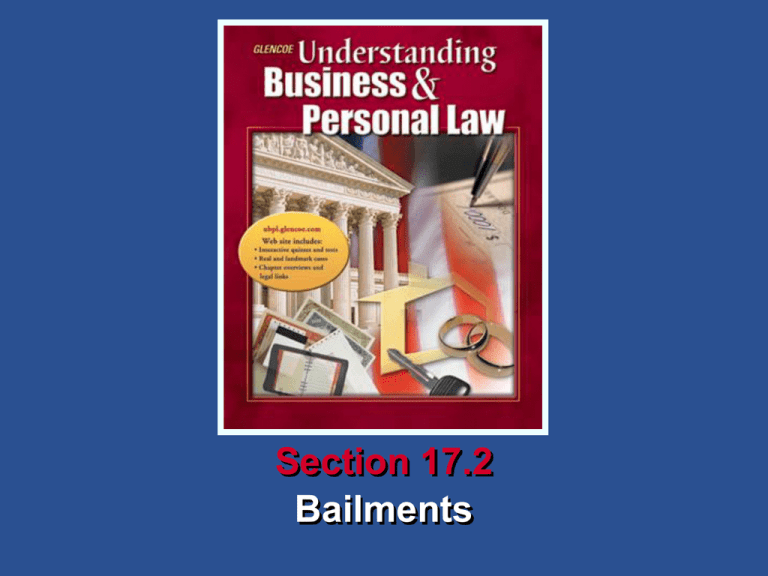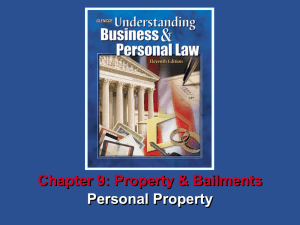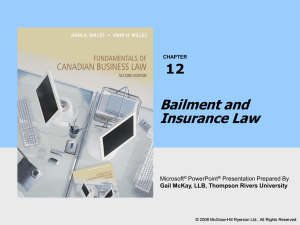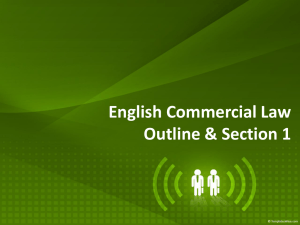bailment
advertisement

Section 17.2 Bailments Section 17.2 Bailments What You’ll Learn How to define a bailment (p. 368) How to describe kinds of bailments (p. 369) Understanding Business and Personal Law Personal Property and Bailments Section 17.2 Bailments What You’ll Learn How to explain who has the burden of proof in bailment lawsuits (p. 373) How to explain hotel keepers’ duties (p. 373) Understanding Business and Personal Law Personal Property and Bailments Section 17.2 Bailments What You’ll Learn How to identify the rights and duties of common carriers (p. 376) How to discuss the obligations of common carriers toward passengers (p. 378) Understanding Business and Personal Law Personal Property and Bailments Section 17.2 Bailments Why It’s Important Understanding the law of bailments can help you avoid difficulties. Understanding Business and Personal Law Personal Property and Bailments Section 17.2 Bailments Legal Terms bailment (p. 368) bailor/bailee (p. 368) mutuum (p. 368) gratuitous bailments (p. 369) gross negligence (p. 370) slight negligence (p. 371) Understanding Business and Personal Law Personal Property and Bailments Section 17.2 Bailments Legal Terms reasonable care (p. 371) ordinary negligence (p. 371) tortious bailee (p. 372) carrier (p. 376) common carrier (p. 376) Understanding Business and Personal Law Personal Property and Bailments Section 17.2 Bailments Section Outline Bailments of Personal Property Main Types of Bailments Bailments for Sole Benefit of Bailor Bailments for Sole Benefit of Bailee Mutual-Benefit Bailments Tortious Bailees Burden of Proof Understanding Business and Personal Law Personal Property and Bailments Section 17.2 Bailments Section Outline Special Bailments Hotel Keepers Common Carriers Understanding Business and Personal Law Personal Property and Bailments Section 17.2 Bailments Pre-Learning Question What is a bailment? Understanding Business and Personal Law Personal Property and Bailments Section 17.2 Bailments Bailments of Personal Property A bailment is the transfer of possession and control of personal property to another with the intent that the same property will be returned later. Understanding Business and Personal Law Personal Property and Bailments Section 17.2 Bailments Bailments of Personal Property Examples of bailments include renting a video leaving your car at the shop for repairs dropping off clothes at the cleaners Understanding Business and Personal Law Personal Property and Bailments Section 17.2 Bailments Bailments of Personal Property The person who transfers the property is the bailor. The person to whom the property is transferred is the bailee. Understanding Business and Personal Law Personal Property and Bailments Section 17.2 Bailments Bailments of Personal Property In a bailment, neither the bailor nor the bailee intends that title to the property should pass. The bailee has an obligation to return the same property to the bailor at a later time. Understanding Business and Personal Law Personal Property and Bailments Section 17.2 Bailments Bailments of Personal Property When you loan goods to someone with the understanding that they will be used and later replaced with different identical goods, a mutuum has occurred. Understanding Business and Personal Law Personal Property and Bailments Section 17.2 Bailments Pre-Learning Question What are some types of bailments? Understanding Business and Personal Law Personal Property and Bailments Section 17.2 Bailments Main Types of Bailments There are three types of bailments: 1. bailments for the sole benefit of the bailor 2. bailments for the sole benefit of the bailee 3. mutual-benefit bailments Understanding Business and Personal Law Personal Property and Bailments Section 17.2 Bailments Main Types of Bailments In the first two types, called gratuitous bailments, property is transferred to another person without either party giving or asking for payments. Understanding Business and Personal Law Personal Property and Bailments Section 17.2 Bailments Bailments for Sole Benefit of Bailor When a personal possession is transferred to another person for purposes that will benefit only the bailor, a bailment for the sole benefit of the bailor results. Understanding Business and Personal Law Personal Property and Bailments Section 17.2 Bailments Bailments for Sole Benefit of Bailor For example, your friend asks you to look after her car while she is away for a week, and you agree to keep her car in your garage. Understanding Business and Personal Law Personal Property and Bailments Section 17.2 Bailments Bailments for Sole Benefit of Bailor The bailee owes a duty to use only slight care, because the bailee is receiving no benefit from the arrangement. The bailee is required only to refrain from gross negligence (very great negligence). Understanding Business and Personal Law Personal Property and Bailments Section 17.2 Bailments Bailments for Sole Benefit of Bailee When personal property is transferred for purposes that will benefit only the bailee, a bailment for the sole benefit of the bailee occurs. Understanding Business and Personal Law Personal Property and Bailments Section 17.2 Bailments Bailments for Sole Benefit of Bailee For example, George offered his truck to Trina, who was moving. Trina accepted the offer and used George’s truck to move. George received no payment. Only Trina received the benefit of the bailment. Understanding Business and Personal Law Personal Property and Bailments Section 17.2 Bailments Bailments for Sole Benefit of Bailee The bailee is required to use great care because possession of the goods is intended solely for the bailee’s benefit. Understanding Business and Personal Law Personal Property and Bailments Section 17.2 Bailments Bailments for Sole Benefit of Bailee The bailee is responsible for even slight negligence, which is the failure to use the care that persons of extraordinary prudence and foresight use. Understanding Business and Personal Law Personal Property and Bailments Section 17.2 Bailments Bailments for Sole Benefit of Bailee The bailee has the right to use the property only for the purpose for which the bailment was created. Understanding Business and Personal Law Personal Property and Bailments Section 17.2 Bailments Mutual-Benefit Bailments A mutual-benefit bailment is one in which both the bailor and the bailee receive some benefit. Understanding Business and Personal Law Personal Property and Bailments Section 17.2 Bailments Mutual-Benefit Bailments For example, if you leave your car at a garage to be repaired, you, the bailor, receive the benefit of a repaired car. The garage, the bailee, receives the benefit of your payment. Understanding Business and Personal Law Personal Property and Bailments Section 17.2 Bailments Mutual-Benefit Bailments The bailee owes a duty to use reasonable care, or the degree of care that a reasonably prudent person would use in the situation. Understanding Business and Personal Law Personal Property and Bailments Section 17.2 Bailments Mutual-Benefit Bailments The bailee is responsible for ordinary negligence, or failing to use the care that a reasonable person would use under the same circumstances. Understanding Business and Personal Law Personal Property and Bailments 17.2 17.2 Bailments Section Mutual-Benefit Bailments Bailment Service or repair Bailor Bailee Owns the item to be Performs the repair or serviced or repaired service work Storage or parking Owns the item to be stored or parked Is responsible for the storing or parking Security for a loan Pledgor, debtor— borrows money Pledgee, creditor— lends money Renting or leasing Rents an item to someone Pay to use an item Bailments by necessity Gives up possession of property Accepts or protects the property Understanding Business and Personal Law Personal Property and Bailments Section 17.2 Bailments Tortious Bailee A tortious bailee refers to a person who wrongfully keeps the lost property of another or knowingly possesses stolen property. Understanding Business and Personal Law Personal Property and Bailments Section 17.2 Bailments Tortious Bailee One who uses a bailed article for a purpose other than agreed upon or who refuses to return property at the termination of the bailment may also be considered a tortious bailee. Understanding Business and Personal Law Personal Property and Bailments Section 17.2 Bailments Burden of Proof If a bailor brings suit against a bailee because the bailed property was damaged, lost, or stolen while in the possession of the bailee, most courts place the burden of proof on the bailee. Understanding Business and Personal Law Personal Property and Bailments Section 17.2 Bailments Burden of Proof The reason is because the bailee is in the best position to know what happened to the bailed property. Understanding Business and Personal Law Personal Property and Bailments Section 17.2 Bailments Pre-Learning Question What are special bailments? Understanding Business and Personal Law Personal Property and Bailments Section 17.2 Bailments Special Bailments Certain types of bailees have special obligations in addition to the duties imposed on all bailees. Special bailees include hotel keepers common carriers Understanding Business and Personal Law Personal Property and Bailments Section 17.2 Bailments Hotel Keepers Hotel keepers are special bailees because of the special nature of the their business. Hotel keepers, or innkeepers, operate a hotel, motel, or inn that regularly offers rooms to the public for a price. Understanding Business and Personal Law Personal Property and Bailments Section 17.2 Bailments Hotel Keepers Hotel keepers have special duties. duty to accept all guests duty of reasonable care--a minimum standard of comfort, safety, and sanitation Understanding Business and Personal Law Personal Property and Bailments Section 17.2 Bailments Hotel Keepers must respect guests’ right of privacy have greater duty of care toward guests’ property by law are insurers of the guests’ property brought into the hotel Understanding Business and Personal Law Personal Property and Bailments Section 17.2 Bailments 1. Jordan’s bat was broken, so he borrowed Julio’s. Who is the bailor? Who is the bailee? Understanding Business and Personal Law Personal Property and Bailments Section 17.2 Bailments ANSWER Bailor —Julio; bailee—Jordan Understanding Business and Personal Law Personal Property and Bailments Section 17.2 Bailments 2. Beth left her car with Steve at CarCraft for repairs. Who is the bailor? Who is the bailee? Understanding Business and Personal Law Personal Property and Bailments Section 17.2 Bailments ANSWER Bailor—Beth; bailee—CarCraft Understanding Business and Personal Law Personal Property and Bailments Section 17.2 Bailments 3. Zenobia attended a conference on global warming at the Convention Center and stayed at a nearby Red Roof Inn. Who is the bailor? Who is the bailee? Understanding Business and Personal Law Personal Property and Bailments Section 17.2 Bailments ANSWER Bailor—Zenobia; bailee—Red Roof Inn Understanding Business and Personal Law Personal Property and Bailments Section 17.2 Bailments Common Carriers A carrier is a business that transports persons, goods, or both. A common carrier is a carrier that is compensated for providing transportation to the general public. Understanding Business and Personal Law Personal Property and Bailments Section 17.2 Bailments Common Carriers As with hotels, common carriers cannot turn away people who ask for their services. Understanding Business and Personal Law Personal Property and Bailments Section 17.2 Bailments Common Carriers of Goods Common carriers of goods are liable for damages to all goods they ship, regardless of whether they are negligent. Understanding Business and Personal Law Personal Property and Bailments 17.2 17.2 Bailments Section Exceptions to Carrier Liability A public enemy Carriers are not liable when damages occur because of An act of God Understanding Business and Personal Law An act of public authority Fault of the shipper Inherent nature of the goods Personal Property and Bailments Section 17.2 Bailments Common Carriers of Passengers A passenger is a person who enters the premises of a carrier with the intention of buying a ticket for a trip. A carrier must use reasonable care in protecting passengers. Understanding Business and Personal Law Personal Property and Bailments Section 17.2 Bailments Common Carriers of Passengers A carrier’s duty of care to its passengers ends, in most cases, when the passenger leaves the carrier’s premises. Understanding Business and Personal Law Personal Property and Bailments Section 17.2 Bailments Common Carriers of Passengers A common carrier must accept all persons who seek passage, with two exceptions. 1. when all available space is occupied or reserved Understanding Business and Personal Law Personal Property and Bailments Section 17.2 Bailments Common Carriers of Passengers 2. when passengers are disorderly, intoxicated, insane, or infected with a contagious disease Understanding Business and Personal Law Personal Property and Bailments Section 17.2 Bailments Bumped Airline Passengers Airlines are required to establish and publish priority rules for determining which passengers holding confirmed reservation space may be denied boarding on an oversold flight. Understanding Business and Personal Law Personal Property and Bailments Section 17.2 Bailments Passenger Baggage Carriers are obligated to accept a reasonable amount of passengers’ baggage. Understanding Business and Personal Law Personal Property and Bailments Section 17.2 Bailments Passenger Baggage A carrier is an insurer of all luggage that is checked through the baggage desk but is not responsible for items that you keep at your seat or in overhead compartments. Understanding Business and Personal Law Personal Property and Bailments Section 17.2 Bailments Section 17.2 Assessment Reviewing What You Learned 1. What is a bailment? Who is the bailor, and who is the bailee? Understanding Business and Personal Law Personal Property and Bailments Section 17.2 Bailments Section 17.2 Assessment Reviewing What You Learned Answer A bailment is the transfer of possession and control of personal property to another with the intent that the same property will be returned later. Understanding Business and Personal Law Personal Property and Bailments Section 17.2 Bailments Section 17.2 Assessment Reviewing What You Learned Answer The bailor is the person who transfers the property. The bailee is the person to whom the property is transferred. Understanding Business and Personal Law Personal Property and Bailments Section 17.2 Bailments Section 17.2 Assessment Reviewing What You Learned 2. Name the three main types of bailments. Understanding Business and Personal Law Personal Property and Bailments Section 17.2 Bailments Section 17.2 Assessment Reviewing What You Learned Answer Bailments for the sole benefit of bailor, bailments for the sole benefit of bailee, and mutual-benefit bailments. Understanding Business and Personal Law Personal Property and Bailments Section 17.2 Bailments Section 17.2 Assessment Reviewing What You Learned 3. Who has the burden of proof in a bailment lawsuit? Understanding Business and Personal Law Personal Property and Bailments Section 17.2 Bailments Section 17.2 Assessment Reviewing What You Learned Answer The bailee—the one who is in the best position to know what happened. Understanding Business and Personal Law Personal Property and Bailments Section 17.2 Bailments Section 17.2 Assessment Reviewing What You Learned 4. What are the hotel keepers’ duties of care to their guests? Understanding Business and Personal Law Personal Property and Bailments Section 17.2 Bailments Section 17.2 Assessment Reviewing What You Learned Answer They must use reasonable care in protecting their guests from harm. They are responsible for injuries to their guests caused by the hotel’s negligence or the negligence of employees. Understanding Business and Personal Law Personal Property and Bailments Section 17.2 Bailments Section 17.2 Assessment Reviewing What You Learned 5. Common carriers are liable for damages to goods unless the damage comes within one of five exceptions. Name the exceptions. Understanding Business and Personal Law Personal Property and Bailments Section 17.2 Bailments Section 17.2 Assessment Reviewing What You Learned Answer (1) acts of God; (2) acts of public enemy; (3) acts of public authorities; (4) acts of the shipper; and (5) the inherent nature of the goods Understanding Business and Personal Law Personal Property and Bailments Section 17.2 Bailments Section 17.2 Assessment Reviewing What You Learned 6. When does a carrier’s duty of care to its passengers end? Understanding Business and Personal Law Personal Property and Bailments Section 17.2 Bailments Section 17.2 Assessment Reviewing What You Learned Answer When the passenger leaves the carrier’s premises. Understanding Business and Personal Law Personal Property and Bailments Section 17.2 Bailments Section 17.2 Assessment Critical Thinking Activity Living Bailments The agricultural class at your school raises small animals such as hamsters, rabbits, and guinea pigs. Every weekend several students take the animals home to feed them. Understanding Business and Personal Law Personal Property and Bailments Section 17.2 Bailments Section 17.2 Assessment Critical Thinking Activity Living Bailments Is this a bailment? What is the extent of care that applies? Explain your answer. Understanding Business and Personal Law Personal Property and Bailments Section 17.2 Bailments Section 17.2 Assessment Critical Thinking Activity Answer Living Bailments Yes. Students may assume different types of bailment in this situation and therefore their answers to the extent of care will vary. Understanding Business and Personal Law Personal Property and Bailments Section 17.2 Bailments Section 17.2 Assessment Legal Skills in Action Airline Responsibilities Airlines face a public relations nightmare almost every day. Planes take off late, flights are cancelled, and luggage is lost. Understanding Business and Personal Law Personal Property and Bailments Section 17.2 Bailments Section 17.2 Assessment Legal Skills in Action Airline Responsibilities Most people don’t realize that common carriers have rules they follow regarding the transportation of passengers. Understanding Business and Personal Law Personal Property and Bailments Section 17.2 Bailments Section 17.2 Assessment Legal Skills in Action Airline Responsibilities Using publishing software, create a brochure that outlines the airline’s responsibilities and exceptions. Include information about bumping and baggage. Understanding Business and Personal Law Personal Property and Bailments Section 17.2 Bailments Section 17.2 Assessment Legal Skills in Action Answer Airline Responsibilities Brochures will vary but should include the responsibilities and exceptions covered in the text. Understanding Business and Personal Law Personal Property and Bailments End of Section 17.2 Bailments








